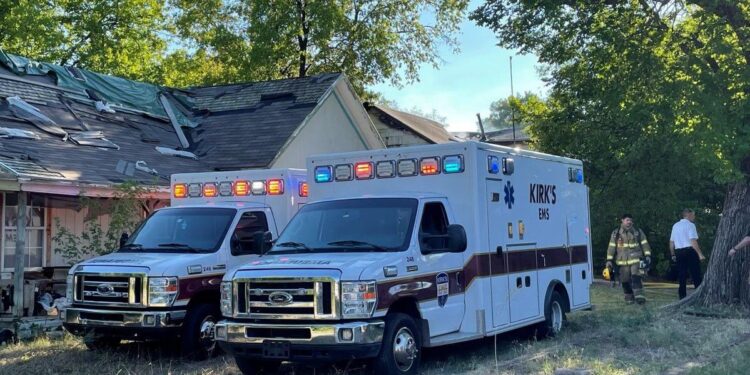When you’re in a medical emergency, often it’s the first responding EMTs and paramedics who make the difference between life and death.
But what happens when there are fewer and fewer of these medical professionals available to answer that call?
That’s the dilemma Kirk’s EMS Director Bruce Crowell faces.
Crowell and Brian Price, information officer for Kirk’s EMS and Heartland Medical Direction, discussed some of the reasons for this shortage.
“It’s a nationwide issue,” said Crowell, who has 30 years of experience in emergency medical services. “It’s not just here.”
Price said call volumes have been higher than ever before in Comanche County, putting stress on reduced resources.
“We want to answer every 911 call and medical service call,” he said. “Every time the phone rings, we want to provide those services. During COVID, we still had to go to work,” he said. “For a good two-year period, we saw things change so much we had to reappraise our mode of operations.”
From working with a shortage of materials, to increasing costs of supplies, Crowell said, it also meant having to take patients places they’d never been before. Calculations would include the amount of time spent taking patients to a destination to allotting the time for travel and determining the amount of equipment needed, he said it was difficult.
“We’d ask, ‘Are we going to have enough oxygen to get the patient where they need to go?’” he said.
The pandemic created other obstacles. Training classes were halted during the height of the pandemic. Price said it limited the number of licensed pre-hospitalization providers across Oklahoma. With only a small pool of qualified applicants, it’s created limitations.
The shortages are across the board, from paramedics to emergency medical technicians, Crowell said. Basic emergency response classes take about six weeks to complete, EMT training takes six to eight months and paramedic training takes two years, he said. It’s challenging to find fully qualified professionals.
“If we could clone paramedics, that would be great,” he said.
Price said one effort is to try and “grow” paramedics through offering incentives through the company for crew members to further their training. In Oklahoma, there is an accelerated paramedic program in place.
There are plenty of educational options available, from tech center programs to courses at Oklahoma City Community College and Oklahoma State University, Crowell said. Those leaving the service also are well suited for the field and often have some of the preliminary training under their belts. He’s seeing more people use online class options for hybrid classes that include in-person clinical training. This doesn’t include the mandatory driving training for ambulances.
Price noted that Kirk’s alone handles on average 1,000 calls a month in Comanche County. The ambulance service has worked with educational entities to allow students opportunity to perform hands-on clinical training with its crews “so they can see it firsthand,” he said. They usually have between one to four students a day pursuing their clinicals.
“We see students from all over Southwest Oklahoma to Oklahoma City do clinicals here,” Crowell said. “It is a lot due to the call volume, but there is an excellent return.”
A “high percentage” of these students return to Kirk’s to work, Price said.
“They’re coming from the inside already,” he said.
The profession also takes a mental toll, Crowell said. There is help outside of professional counseling through a statewide peer support team in conjunction with Heartland.
“The mental health impact can be overwhelming,” he said. “We have six people here that also help across Oklahoma.”
Price said peer support offers those who face burn out themselves to be there for their brothers and sisters facing many of the same problems and issues. A bad service call can mess you up. Now, he said, you have somebody to talk to and that includes follow-ups.
“It’s not a one-time thing,” he said. “You’ve got that help right on your shift. It’s the right directive to keep people in the profession.”
Because it’s not just bringing new people into the field but also keeping those trained, qualified and experienced in the field that’s important, Crowell said. With different variables including any sort of tragedy you can imagine, it takes someone with the right stuff, he said.
“It takes a special breed and character of a person,” he said. “It takes that special person.”
Want to reach a local audience and grow your business?
Our website is the perfect platform to connect with engaged readers in your local area.
Whether you're looking for banner ads, sponsored content, or custom promotions, we can tailor a package to meet your needs.
Contact us today to learn more about advertising opportunities!
CONTACT US NOW



